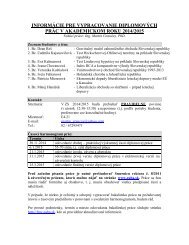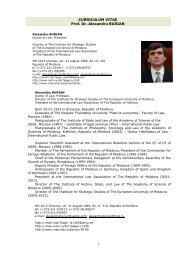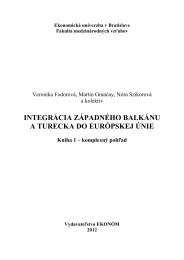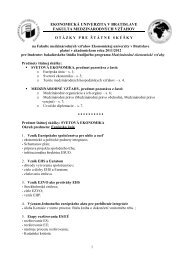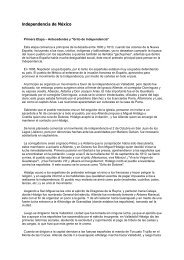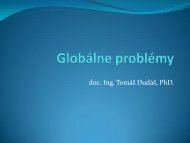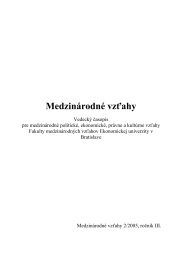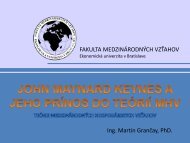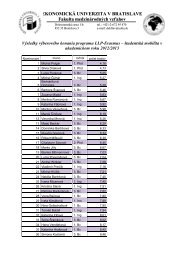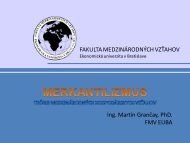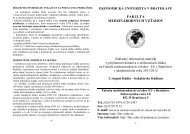rozvojová pomoc a spolupráca - Fakulta medzinárodných vzťahov
rozvojová pomoc a spolupráca - Fakulta medzinárodných vzťahov
rozvojová pomoc a spolupráca - Fakulta medzinárodných vzťahov
- No tags were found...
You also want an ePaper? Increase the reach of your titles
YUMPU automatically turns print PDFs into web optimized ePapers that Google loves.
United Nations 161 , there were more than 850 million undernourished people inthe world between 2001 and 2003. About 20 % of world’s population (richestquintile) accounts for 80 % of resource use in one year. Average Sub-Saharanfamily uses approximately 12 times less water per day as an equally largefamily in the USA. If one person from Singapore makes 4 flights a year onaverage, in Sub-Saharan Africa only every 500 th person gets to fly with anairplane in a year. Manager of a multinational company can have up to 10,000times higher salary as is the wage of an unskilled worker in one of the poordeveloping states.We can similarly attach to any state a so-called ecological footprint,which stands for an area of land necessary to support ones life style.Differences in its value represent differences in material and energy use amongspecific states. The results in given values could be translated as either howmuch resources and energy uses each state and what is its impact on theenvironment (from local ecosystems to biosphere), or what is the connectionbetween real incomes and consumption of particular state.In MIT’s publication The Limits to Growth 162 , and in its reedited versiontitled Beyond the Limits to Growth 163 , the authors suggested a globallysustainable level of incomes for the world’s population of 4 billion. Theaverage - sustainable - per capita income would be 12,500 USD. With apopulation of 4 billion total world GDP is 50 x 10 12 USD and this numberrepresents a level of global economic activity that meets environmentalconstraints and doesn’t generate environmental, economic or social problems.It is therefore considered as sustainable 164 .161 FAO: The state of food insecurity in the world - 2006. Food and Agriculture Organizationof the United Nations, 2006.162 MEADOWS et al.: The limits to growth: a report for the Club of Rome's project on thepredicament of mankind. Universe Books, 1972.163 MEADOWS et al.: Beyond the limits: global collapse or a sustainable future? Earthscan,1992.164 Its actual value has been derived as half of the average US per capita income in 1970. Ifthe total world GDP of 50 trillion USD is to be equally distributed among 6.5 billionpeople, each one would get 7,700 USD. If 1 billion people want to retain their standard ofliving with incomes of USD 25,000 per capita, about 25,000 trillion USD of remainingworld GDP would have to be divided among 5.5 billion people (income of USD 4,500 percapita per person).127



